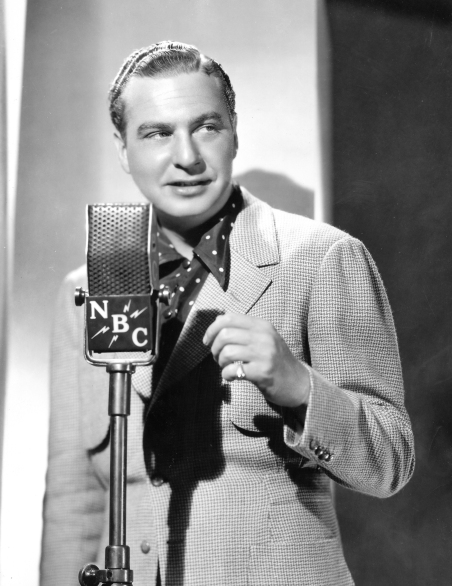
Jack Benny: Where’s your Christmas spirit?
Phil Harris: I drank it!
Durante’s nose. Groucho’s eyebrows. Veronica’s peek-a-boo bangs. Some people just have that one characteristic in particular that becomes a personal identifier. And then, there’s Phil Harris. He’s a fellow who isn’t so much identified by any one physical trait, but as soon as he’d start talking, his voice would prompt an avalanche of memories of familiar characters—for example, a happy-go-lucky bear in The Jungle Book, a smooth, swinging alley cat in The Aristocats, or even, well, Phil Harris!
Harris was born on June 24, 1904, in the small coal-mining town of Linton, Indiana, as the son of two vaudevillians, Harry and Dollie Harris. He mostly lived with his grandmother at 190 Northeast E Street in Linton. His father inspired him to play a wide variety of instruments, and by age nine, Harris was drumming at the Nicklo Theater in Linton, and providing sound effects for the shows.
When Harris turned 11, his family moved to Nashville, causing Harris to identify himself as more of a Southerner, which became the backbone of his show business identity. Still a teen, Harris found employment as the drummer for Francis Craig’s Orchestra and was the main attraction of the band. Discarding his stage name “Wonga Phillip,” he switched back to Phil Harris and formed his own group, “The Dixie Syncopators.” The group performed throughout the South, with Harris providing comedic vocals. Later, he moved the orchestra to Los Angeles, where they headquartered in the Cocoanut Grove during the mid-1930s.
Enthusiastically living the life of a musician, Harris mused: “A bandleader has to be more than a musician, conductor, businessman and promoter. He must be a psychologist, diplomat, and occasionally, a bit of a hero, too.”
On September 2, 1927, Harris married actress Marcia Ralston in Melbourne, Australia, where his band had a long engagement. The couple adopted a son, Phil Harris Jr. Harris and Marcia divorced in September 1940.
Additionally, Harris’ group starred in several Hollywood shorts and found routine work in radio, with his vocalists Leah Ray and Ruth Robin. In 1936, Harris became the musical director for the Jack Benny show, taking on the persona of a carousing bandleader. He proved to be an excellent supporting comic and quickly became a beloved character on The Jack Benny Program.
In 1941, Harris married actress Alice Faye. The couple hosted the Fitch Bandwagon Show from 1946 to 1948 and moved on to their own radio program, The Phil Harris-Alice Faye Show, from 1948 to 1954. Harris’ personality, however, was the key to the show. Having worked with Jack Benny for ten years, he had no problem carrying a show.
Happily married, with three children (Phil Jr., Phyllis, and Alice), a luxurious home, and a booming career, Harris maintained: “I have everything a man wants in life—except, of course, enough sleep.”
What’s more, Benny’s writers made a big deal out of Harris’ marriage. His character was originally written as more of a philanderer but was very effectively revised as a devoted husband and father. The writers for Harris’ show played upon the ideas of Benny’s writers and continued crafting Harris’ character around the same image. Harris played an egotistical bandleader, while Faye was his movie starlet-turned-wife, and they both shone in a comedy based upon domestic life.
Working two radio shows at the same time proved to be quite the juggling act. On the Jack Benny show, Harris would greet Benny with a throaty, “Hiya, Jackson!,” perform in a skit or song, and shout, “Bye, Jackson!” on the way out. He would only appear for the first half of the Jack Benny show. He’d then run down the block to the next studio, just in time to catch his own radio show with a “Hiya, Alice!” and continue on through the remainder of the program. In 1952, he was succeeded as Benny’s orchestra leader by Bob Crosby, younger brother of Bing Crosby.
Throughout his long show business career, Harris remained grateful to radio for the difference it made in his professional and personal life. “If it hadn’t been for radio,” he was quoted as saying, “I would still be a traveling orchestra leader. For 17 years, I played one-night stands, sleeping on buses. I never even voted, because I didn’t have any residence.”

After his radio show ended in 1954, he faded from Hollywood life and spent time as a businessman in Palm Springs, while becoming a spokesperson and benefactor for its golf courses. Additionally, he was a benefactor of his birthplace, Linton, and established scholarships in his honor for high school students, performed at the high school, and hosted a celebrity golf tournament at the Phil Harris Golf Course each year in the first week of June.
The marriage between Harris and Faye lasted 54 years until his death.

Harris and Faye donated most of their show business memorabilia and papers to Linton’s Margaret Cooper Public Library in 1979 in connection with the first Phil Harris weekend at his golf course. This is one of the most important legacies Harris left to his hometown of Linton. Since then, the collection has shifted around quite a bit. Originally the collection was located upstairs in the Margaret Cooper Public Library. In the spring of 1998, the collection was relocated to the basement of the current Regions Bank at 89 West Vincennes Street.

The Linton-Stockton School Corporation website details the collection as follows: “The memorabilia is a virtual history of show business and represents much of the lives and careers of both Harris and his wife. The collection has provided hours of pleasure for visitors. It is an important source of information about the Harrises. The collection includes photos, scrapbooks, clippings, awards, and magazines.”
As a tribute to his hometown that gave him so many childhood memories, Harris started a scholarship program from the proceeds of the Phil Harris Weekend. In addition, he and his wife donated personal mementos, which were housed in the Phil Harris-Alice Faye Collection.
Sadly, the collection now includes memorabilia relating to Harris’ death on August 11, 1995, at age 91, just a few weeks after he returned to his beloved Linton for his last Phil Harris Scholarship Festival. Harris is at rest in California at Forest Lawn–Cathedral City, but a large part of his legacy continues to live on in the Harris-Faye Collection in his hometown of Linton, Indiana.
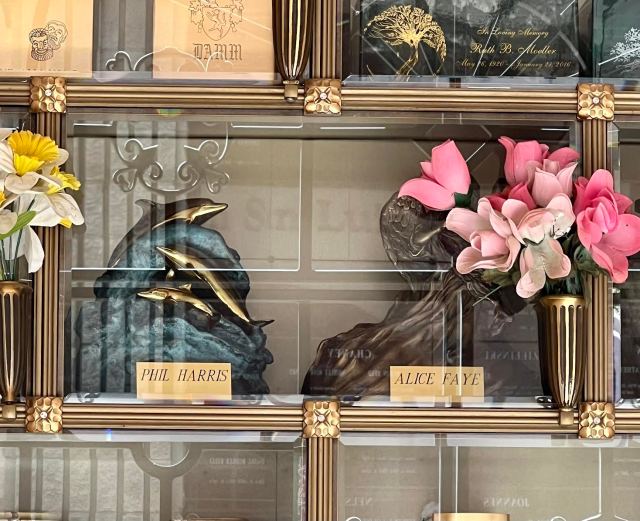
Today, Linton, Indiana, is still a small town of roughly 5,800 people. Its trademark “You’ll Like Linton” sign still stands.
On the way into town, visitors can spot a marker noting Linton as the birthplace of Harris.

Today, the Harris-Faye collection resides in the Carnegie Heritage and Arts Center of Greene County, located at 110 E. Vincennes St., Linton, Indiana. The building is mostly a shop for local art, and the collection is tucked away in its own corner. Luckily it is free to view the Harris-Faye collection, and there is ample street parking available.
Although the Phil Harris Celebrity Weekend is no more, as both Harris and his close friend who carried on the tradition have passed away, the Phil Harris Golf course still stands at Indiana 54, Linton, Indiana. The county now owns and operates the Phil Harris Scholarship Tournament.
As of my most recent visit in 2022, the sign to the golf course has since been changed.

I was also able to visit inside the pro shop and was pointed to various photographs commemorating Harris’ time at the course.
Today, the course is referred to as “The Phil.” Visitors can also purchase some golf gear and accessories with “The Phil” emblazoned on them.

According to the gentlemen at the pro shop, this whole driveway would be flooded with cars due to the number of people ready to participate in or watch the tournament.

Additional guests at the pro shop also told me that Harris would be presented with the monetary award at the tournament, and he would ceremoniously receive the big check and hand it over to the school to fund the scholarship, year after year.
Aside from the course carrying Harris’ name, one of the most direct tributes to him includes this plaque, located just in front of the pro shop.
The plaque reads:
“Known across the country for his ability to entertain through music and humor, Phil Harris is also widely recognized for his accomplishments in golf. He became so much a part of the Crosby National Pro-Am as Bing himself and won the events in 1951 with Dutch Harrison. Phil helped organize the first major tournament in the Palm Springs area, which became the Bob Hope Desert Classic. Harris later became involved with the Legends of Golf, Nabisco Dinah Shore, AT&T Pebble Beach as well as many other pro-ams and benefits from across the United States. He was born in Linton in 1904 and was honored by the city when the golf course was renamed after him in 1970. The golf course became the site of the Phil Harris Scholarship Golf Tournament. Through his efforts in Linton, Phil has ensured that kids from his hometown will forever have the chance to attend college. Because of his generosity, we pay tribute to a great American institution–Phil Harris.”
Beyond Linton, the Great American Songbook Foundation houses the Phil Harris – Alice Faye Arrangements, approximately 140 musical arrangements for the weekly radio show The Phil Harris – Alice Faye Show. The foundation is located at 1 Carter Green, Carmel, Indiana, with an off-site archive.
Harris is remembered with two stars on the Hollywood Walk of Fame, honoring his work in recording and radio. They are located at 6508 Hollywood Blvd. and 6651 Hollywood Blvd., Los Angeles, California, respectively.
In Palm Springs, Harris is also represented on the Walk of Stars with a Golden Palm at 123 N. Palm Canyon Dr., Palm Springs, California.
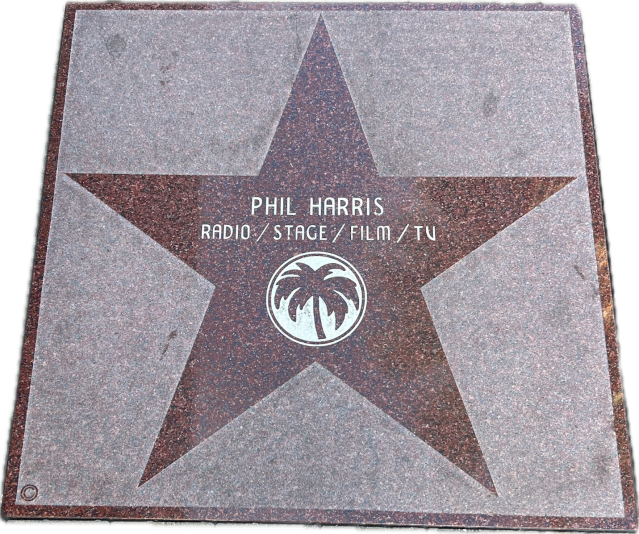
While Linton is still a quiet spot on the map, it’s most likely just as Harris would have remembered it. I think it compliments Harris’ laid-back personality and would have provided a nice break from the chaos of traveling city after city as a bandleader. Harris puts it all into perspective for us, as always:



















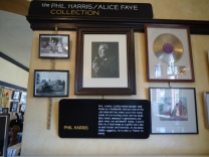












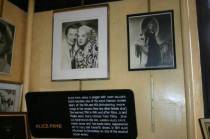

















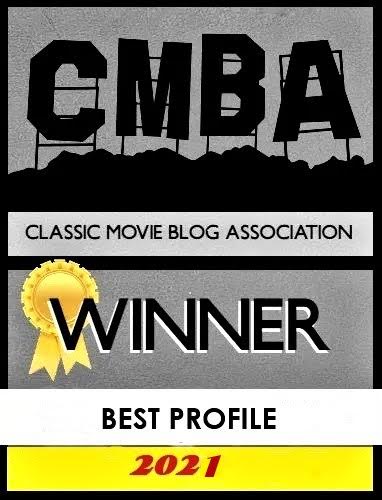



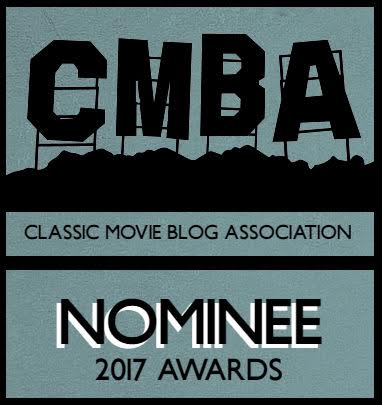

What a wonderful tribute to such a great personality! So informative and interesting….thank you so much for posting this on our FB Jack Benny Fans (New) page and for joining us there also!
Thank you so much! I look forward to keeping up with the group’s updates! 🙂
Terrific blog. I’m going to re-post this from my wordpress page. meantime, here’s my own post about Phil Harris: https://travsd.wordpress.com/2013/06/24/phil-harris/
Thanks for reading! I’ll be sure to check out your piece on Phil Harris, as well!
Like a guided tour of the place!
Glad you enjoyed it!
My Aunt Alma Anderson was the town nurse in Linton for decades. She always reminded everyone that she delivered Phil Harris. In fact, Aunt Alma delivered most Lintontonians. My dad and Used to go fishing with her because she knew everyone, and everyone let her fish in their private ponds.
That is so interesting! Do you remember any stories she told about Phil?
I love listening to the Phil Harris and Alice Faye radio show. A wonderful couple and fun cast. Great article! Thanks for posting.
Such an interesting and delightful read. I don’t, however, remember Phil and Alice having a son. Anyone knows?
Phil Jr. was from a previous wife– an Australian lady, I believe.
Adopted as a newborn during that first marriage. After divorce, he lived with his mother (who had parts in Hollywood.) This according to: http://greatentertainersarchives.blogspot.com/2014/04/the-son-of-phil-harris.html
Thank you for the clarification.
Pingback: Rochester and Jack: Breaking Racial Barriers | Hometowns to Hollywood
So we know where he grew up in Linton; curiosity, do we know where he grew up in Nashville? Assuming any home(s) are still standing; I know with Jack Benny for example, you can find most of the places he grew up but only one is still around. I might be heading to Nashville soon so it would be nice to stop by and see where his legend really took off.
Pingback: TCM Film Festival 2022 Picks | Hometowns to Hollywood